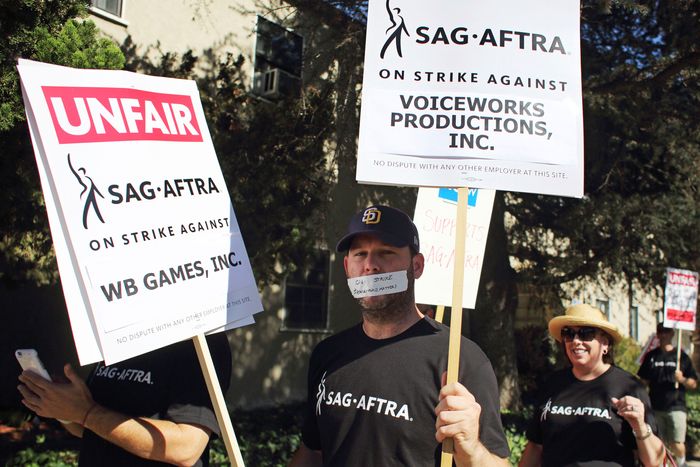
While WGA members drew their negotiations to a close last month, a possible strike looms over another sector of actors within the entertainment industry, and they worry their jobs might disappear entirely. On September 25, SAG-AFTRA members overwhelmingly voted in favor of a strike authorization for workers within the video-game industry in an effort to move negotiations toward their favor. Here’s everything you need to know about it so far.
Who’s Involved in the Battle for Fair Wages
Under the Interactive Media Agreement, SAG-AFTRA protects voice actors, on-camera (motion-capture, stunt) performers, stunt coordinators, singers, dancers, puppeteers, and background performers in video-game and interactive media. Much like their Hollywood counterparts, video-game actors work primarily through independent contracts, which SAG-AFTRA standardizes. On the other side of the bargaining table are ten major video-game studios, which include Activision, Electronic Arts, and Epic Games — industry giants responsible for games like Call of Duty, Apex Legends, and Fortnite.
Video-Game Actors Could Potentially Enter the Picket Line … a Second Time
In 2016, SAG-AFTRA went on strike against 11 major video-game studios after failing to reach an agreement over stagnating base pay, health and safety issues related to vocally strenuous performance roles, strict nondisclosure work contracts, and the lack of residual pay within the industry. The result was SAG-AFTRA’s longest strike to date, lasting 340 days until both sides negotiated a compromise.
By the end of the 2016 video-game actors’ strike, many union members expressed discontent with the current agreement, saying the current contract still hosted lackluster health regulations and did not hold the competitive residual pay SAG-AFTRA initially fought for. Some of these issues carried over to this year’s negotiations, which began October 2022.
AI Threatens to Ruin Things Again
In this round of negotiations, SAG-AFTRA is asking for more basic set protections and an increase in video-game actors’ base and bonus pay to keep up with inflation. However, much like this summer’s writers’ strike and the ongoing Hollywood actors’ strike, a new focus in negotiation centers on the industry’s unregulated use of AI.
As of now, video-game actors currently have no protections against game-development companies replicating their voice and kinetic performance through AI. At the cost of putting the nuances of acting aside, this means game companies can now put video-game actors out of work permanently by having software easily churn out lines and movement.
“Between the exploitative uses of AI and lagging wages, those who work in video games are facing many of the same issues as those who work in film and television,” SAG-AFTRA’s chief contracts officer, Ray Rodriguez, said via press release. “Our members’ livelihoods depend on it.”
How Could Video Games Be Affected?
Unlike the TV and film industry, which grinded to a halt this summer after writers and, later on, actors organized, a SAG-AFTRA strike wouldn’t immediately affect video-game production. Acting does not make up a large portion of video-game development, which means major upcoming titles like Marvel’s Wolverine could continue development with little to no issues.
That doesn’t mean a strike wouldn’t have an effect on the industry. Negotiating companies like Forsoma Interactive provide subcontracted motion-capture and voice-acting work for studios such as Sony, Square Enix, and Kojima Productions. A potential strike could easily delay game development outside of the ten studios in talks with SAG-AFTRA. On top of that, workers at companies like Activision Blizzard are starting to unionize, which puts video-game actors on a better playing field. Let’s not forget that the 2016 video game actors’ strike did affect the development of a handful of major titles such as Life Is Strange: Before the Storm and What Remains of Edith Finch.
So … What’s Next?
As of now, SAG-AFTRA and video-game companies have not reached an agreement. The two concluded scheduled negotiations for the Interactive Media Agreement on September 28, with the union announcing via a joint press release that both parties are making final efforts to reach a deal. A strike won’t happen if SAG-AFTRA and video-game companies reach a consensus on the Interactive Media Agreement. If they don’t, the union could easily initiate the strike.
When SAG-AFTRA makes that decision isn’t clear yet. This week, Hollywood union members headed back to the bargaining table to resume talks with the AMPTP. However, that doesn’t affect video-game actors’ final attempts at bargaining. In the meantime, their current contract with employers remains in effect.
“I remain hopeful that we will be able to reach an agreement that meets members’ needs, but our members are done being exploited,” Duncan Crabtree-Ireland, SAG-AFTRA’s national executive director and chief negotiator, said via a joint press release. “And if these corporations aren’t willing to offer a fair deal, our next stop will be the picket lines.”
“We are continuing to negotiate in good faith to reach an agreement that reflects the important contributions of SAG-AFTRA-represented performers in video games,” Audrey Cooling, a spokesperson for the video game producers party to the Interactive Media Agreement, said in a statement. “We have reached tentative agreements on over half of the proposals and are optimistic we can find a resolution at the bargaining table.”
This article has been updated with additional information.

